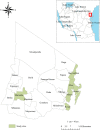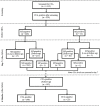Efficacy of ivermectin and albendazole combination in suppressing transmission of lymphatic filariasis following mass administration in Tanzania: a prospective cohort study
- PMID: 38867265
- PMCID: PMC11167743
- DOI: 10.1186/s40249-024-01214-3
Efficacy of ivermectin and albendazole combination in suppressing transmission of lymphatic filariasis following mass administration in Tanzania: a prospective cohort study
Abstract
Background: Preventive chemotherapy with ivermectin and albendazole (IA) in mass drug administration (MDA) programs for all at-risk populations is the core public health intervention to eliminate lymphatic filariasis (LF). Achieving this goal depends on drug effectiveness in reducing parasite reservoirs in the community to halt transmission. We assessed the efficacy of ivermectin and albendazole in clearing microfilariae and circulating filarial antigens (CFA) following MDA.
Methods: This community-based prospective study was conducted in Mkinga district, Tanga region, Tanzania, from November 2018 to June 2019. A total of 4115 MDA-eligible individuals were screened for CFA using Filarial test strips. CFA positives were re-examined for microfilariae by microscopy. CFA and microfilariae positive individuals were enrolled and received IA through MDA campaign. The status of microfilariae and CFA was monitored before MDA, and on day 7 and six-month following MDA. The primary efficacy outcomes were the clearance rates of microfilariae on day 7 and six-months, and CFA at 6 months of post-MDA. The McNemar test assessed the proportions of microfilariae positive pre- and post-MDA, while Chi-square tests were utilized to examine factors associated with CFA status six months post-MDA.
Results: Out of 4115 individuals screened, 239 (5.8%) tested positive for CFA, of whom 11 (4.6%) were also positive for microfilariae. Out of the ten microfilariae-positive individuals available for follow-up on day 7, nine tested negative, yielding a microfilariae clearance rate of 90% [95% confidence interval (CI): 59.6-98.2%]. Participants who tested negative for microfilariae on day 7 remained free of microfilariae six months after MDA. However, those who did not clear microfilariae on day-7 remained positive six-months post-MDA. The McNemar test revealed a significant improvement in microfilariae clearance on day 7 following MDA (P = 0.02). Out of 183 CFA-positive individuals who were available at 6-month follow-up, 160 (87.4%) remained CFA positive, while 23 became CFA negative. The CFA clearance rate at 6 months post-MDA was 12.6% (95% CI: 8.5-8.5%). There was no significant association of variability in ivermectin plasma exposure, measured by maximum concentration or area under the curve, and the clearance status of microfilariae or CFA post-MDA.
Conclusions: Preventive chemotherapy with IA effectively clears microfilariae within a week. However, it is less effective in clearing CFA at six months of post-MDA. The low clearance rate for filarial antigenemia underscores the need for alternative drug combinations and additional preventive measures to achieve LF elimination by 2030.
Keywords: Albendazole; Circulating filarial antigen; Efficacy; Ivermectin; Lymphatic filariasis; Mass drug administration; Microfilariae; Tanzania.
© 2024. The Author(s).
Conflict of interest statement
The authors declare that they have no competing interests.
Figures




Similar articles
-
Safety and effectiveness of triple-drug therapy with ivermectin, diethylcarbamazine, and albendazole in reducing lymphatic filariasis prevalence and clearing circulating filarial antigens in Mombasa, Kenya.Infect Dis Poverty. 2025 Feb 24;14(1):11. doi: 10.1186/s40249-025-01282-z. Infect Dis Poverty. 2025. PMID: 39994719 Free PMC article.
-
Changes in circulating filarial antigen status in previously positive individuals: Lessons for treatment monitoring and pre-transmission assessment surveys.PLoS Negl Trop Dis. 2025 Feb 4;19(2):e0012802. doi: 10.1371/journal.pntd.0012802. eCollection 2025 Feb. PLoS Negl Trop Dis. 2025. PMID: 39903788 Free PMC article.
-
Triple-drug therapy with ivermectin, diethylcarbamazine and albendazole for the acceleration of lymphatic filariasis elimination in Kenya: Programmatic implementation and results of the first impact assessment.PLoS Negl Trop Dis. 2024 Jul 8;18(7):e0011942. doi: 10.1371/journal.pntd.0011942. eCollection 2024 Jul. PLoS Negl Trop Dis. 2024. PMID: 38976718 Free PMC article.
-
Albendazole alone or in combination with microfilaricidal drugs for lymphatic filariasis.Cochrane Database Syst Rev. 2019 Jan 8;1(1):CD003753. doi: 10.1002/14651858.CD003753.pub4. Cochrane Database Syst Rev. 2019. PMID: 30620051 Free PMC article.
-
An analysis of the safety of the single dose, two drug regimens used in programmes to eliminate lymphatic filariasis.Parasitology. 2000;121 Suppl:S147-60. doi: 10.1017/s0031182000007423. Parasitology. 2000. PMID: 11386686 Review.
Cited by
-
Safety and effectiveness of triple-drug therapy with ivermectin, diethylcarbamazine, and albendazole in reducing lymphatic filariasis prevalence and clearing circulating filarial antigens in Mombasa, Kenya.Infect Dis Poverty. 2025 Feb 24;14(1):11. doi: 10.1186/s40249-025-01282-z. Infect Dis Poverty. 2025. PMID: 39994719 Free PMC article.
References
-
- Global programme to eliminate lymphatic filariasis: progress report, 2022. Geneva, World Health Organization. Weekly epidemiological record No 41. 2023;98:489. https://iris.who.int/bitstream/handle/10665/373356/WER9841-eng-fre.pdf?s.... Accessed 20 May 2024.
-
- Guideline: alternative mass drug administration regimens to eliminate lymphatic filariasis. World Health Organization 2017. License: CC BY-NC-SA 3.0 IGO https://apps.who.int/iris/handle/10665/259381. Accessed 20 May 2024. - PubMed
-
- Cano J, Basanez MG, O'Hanlon SJ, Tekle AH, Wanji S, Zoure HG, et al. Identifying co-endemic areas for major filarial infections in sub-Saharan Africa: seeking synergies and preventing severe adverse events during mass drug administration campaigns. Parasit Vectors. 2018;11:70. doi: 10.1186/s13071-018-2655-5. - DOI - PMC - PubMed
MeSH terms
Substances
Grants and funding
LinkOut - more resources
Full Text Sources

